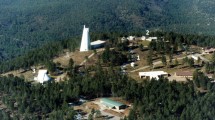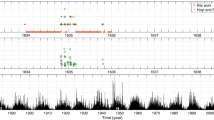Abstract
The importance of the periodicity in sunspot appearance was well recognized by the mid-19th century. Several observatories around the globe have made the record of sunspots in the form of drawings and preserved them safely for posterity. At the Kodaikanal Observatory (KO), the sunspot observations have begun in 1905. In those times observations were recorded on photographic plates and after the development of those plates in the laboratory, the drawings of the same were made on the Stonyhurst grids. In these drawings, called sun charts, different features on the sun’s disk, e.g., sunspots, plages, filaments, prominences, etc. were clearly identified and visually marked with different colors. We have collected 111 years of sunspot drawing spanning over 10 solar cycles. These sunspot drawings were carefully stitched to make bound volumes, each for every 6-months. The drawings are kept at the Kodaikanal library for scientific use and analysis. In this article, we describe briefly the process of drawing, methods of counting sunspot numbers and measurement of sunspot area using square grids. We have collected the data for the northern and southern hemispheres separately. From the collected data, we compute the sunspot number and area and compare it with Royal Greenwich Observatory (RGO) and Sunspot Index and Long-term Solar Observations (SILSO) data. The results show that the measurement of the sunspot number is underestimated by about 40%. The KO monthly averaged sunspot number data of both hemispheres is normalized with the RGO monthly averaged total sunspot number data. This procedure provided a good correlated data set that can be used for further scientific work in the future. The sunspot area data from KO is slightly underestimated in the first 5-cycles and seems mildly overestimated in the later 5-cycles. These data sets are valuable additions to the existing data of sunspot records.










Similar content being viewed by others
References
Arlt, R.: Sol. Phys. 247(2), 399 (2008). https://doi.org/10.1007/s11207-007-9113-4
Arlt, R.: Sol. Phys. 255(1), 143 (2009). https://doi.org/10.1007/s11207-008-9306-5. arXiv:0812.2233
Arlt, R.: Astron. Nachr. 332(8), 805 (2011). https://doi.org/10.1002/asna.201111601. arXiv:1110.3620
Babcock, H.W.: Astrophys. J. 133, 572 (1961). https://doi.org/10.1086/147060
Baranyi, T., Győri, L., Ludmány, A.: Sol. Phys. 291(9–10), 3081 (2016). https://doi.org/10.1007/s11207-016-0930-1. arXiv:1606.00669
Carrington, R.C.: Observations of the Spots on the Sun from November 9, 1853 to March 24, 1861. Williams and Norgate, London (1863)
Charbonneau, P.: Living Rev. Sol. Phys. 7(1), 3 (2010). https://doi.org/10.12942/lrsp-2010-3
Cram, L.E.: Sol. Phys. 69(2), 411 (1981). https://doi.org/10.1007/BF00150005
Hanaoka, Y.: Solar Observatory of NAOJ. In: Dorotovic, I., Fischer, C.E., Temmer, M. (eds.) Past and Present of the Synoptic Observations of the Sun at the National Astronomical Observatory of Japan. Astronomical Society of the Pacific Conference Series, vol. 504, p. 313 (2016)
Hathaway, D.H.: Living Rev. Sol. Phys. 7(1), 1 (2010). https://doi.org/10.12942/lrsp-2010-1
Hathaway, D.H.: Living Rev. Sol. Phys. 12(1), 4 (2015). https://doi.org/10.1007/lrsp-2015-4. arXiv:1502.07020
Howard, R.: Sol. Phys. 100, 171 (1985). https://doi.org/10.1007/BF00158427
Howard, R.F., Gupta, S.S., Sivaraman, K.R.: Sol. Phys. 186, 25 (1999). https://doi.org/10.1023/A:1005153925209
Hoyt, D.V., Schatten, K.H.: Sol. Phys. 179(1), 189 (1998). https://doi.org/10.1023/A:1005007527816
Jørgensen, C.S., Karoff, C., Senthamizh Pavai, V., Arlt, R.: Sol. Phys. 294(6), 77 (2019). https://doi.org/10.1007/s11207-019-1465-z. arXiv:1906.10884
Li, K.J., Gao, P.X., Zhan, L.S.: Sol. Phys. 254(1), 145 (2009). https://doi.org/10.1007/s11207-008-9284-7
Lin, G.H., Wang, X.F., Liu, S., Yang, X., Zhu, G.F., Deng, Y.Y., Ji, H.S., Zhou, T.H., Sun, L.N., Feng, Y.L., Liu, Z.Z., Tao, J.P., Ben, M.X., Lin, J., Ding, M.D., Li, Z., Zheng, S., Zeng, S.G., He, H.L., Zeng, X.Y., Shu, Y., Sun, X.B.: Sol. Phys. 294(6), 79 (2019). https://doi.org/10.1007/s11207-019-1456-0. arXiv:1904.12316
Mandal, S., Chatterjee, S., Banerjee, D.: Astrophys. J. 835(2), 158 (2017a). https://doi.org/10.3847/1538-4357/835/2/158. arXiv:1612.05711
Mandal, S., Hegde, M., Samanta, T., Hazra, G., Banerjee, D., Ravindra, B.: Astron. Astrophys. 601, 106 (2017b). https://doi.org/10.1051/0004-6361/201628651. arXiv:1608.04665
Meadows, P.: J. Br. Astron. Assoc. 112, 353 (2002)
Ravindra, B., Priya, T.G., Amareswari, K., Priyal, M., Nazia, A.A., Banerjee, D.: Astron. Astrophys. 550, 19 (2013). https://doi.org/10.1051/0004-6361/201220416. arXiv:1212.4776
Sivaraman, K.R., Gupta, S.S., Howard, R.F.: Sol. Phys. 189(1), 69 (1999). https://doi.org/10.1023/A:1005277515551
Spoerer, F.W.G.: Astron. Nachr. 55(19), 289 (1861). https://doi.org/10.1002/asna.18610551902
Temmer, M., Veronig, A., Hanslmeier, A.: Astron. Astrophys. 390, 707 (2002). https://doi.org/10.1051/0004-6361:20020758. arXiv:astro-ph/0208436
Temmer, M., Rybák, J., Bendík, P., Veronig, A., Vogler, F., Otruba, W., Pötzi, W., Hanslmeier, A.: Astron. Astrophys. 447(2), 735 (2006). https://doi.org/10.1051/0004-6361:20054060
Usoskin, I.G.: Living Rev. Sol. Phys. 14(1), 3 (2017). https://doi.org/10.1007/s41116-017-0006-9
Usoskin, I.G., Mursula, K., Arlt, R., Kovaltsov, G.A.: Astrophys. J. Lett. 700(2), 154 (2009). https://doi.org/10.1088/0004-637X/700/2/L154. arXiv:0907.0063
Waldmeier, M.: The Sunspot-Activity in the Years 1610–1960 (1961)
Willis, D.M., Coffey, H.E., Henwood, R., Erwin, E.H., Hoyt, D.V., Wild, M.N., Denig, W.F.: Sol. Phys. 288(1), 117 (2013). https://doi.org/10.1007/s11207-013-0311-y
Wolf, R.: Mitt. Nat.forsch. Ges. Bern 207, 89 (1851)
Wolfer, A.: Pop. Astron. 10, 449 (1902)
Zirin, H.: Astrophysics of the Sun, p. 303 (1988)
Acknowledgements
We thank the referee for fruitful comments. The data used here is proprietary of the Kodaikanal Solar Observatory. We thank all the observers who made the observations over the period of 115-years and also made the drawings and sketches of all the features on the sun chart. Special thanks to Anitha, Jayalakshmi, Avanthika, Madhumitha for cross examining the sunspot numbers. SILSO sunspot number data used in this study are provided by the Royal Observatory of Belgium, Brussels.
Author information
Authors and Affiliations
Corresponding author
Additional information
Publisher’s Note
Springer Nature remains neutral with regard to jurisdictional claims in published maps and institutional affiliations.
Rights and permissions
About this article
Cite this article
Ravindra, B., Pichamani, K., Selvendran, R. et al. Sunspot drawings at Kodaikanal Observatory: a representative results on hemispheric sunspot numbers and area measurements. Astrophys Space Sci 365, 14 (2020). https://doi.org/10.1007/s10509-020-3725-7
Received:
Accepted:
Published:
DOI: https://doi.org/10.1007/s10509-020-3725-7




